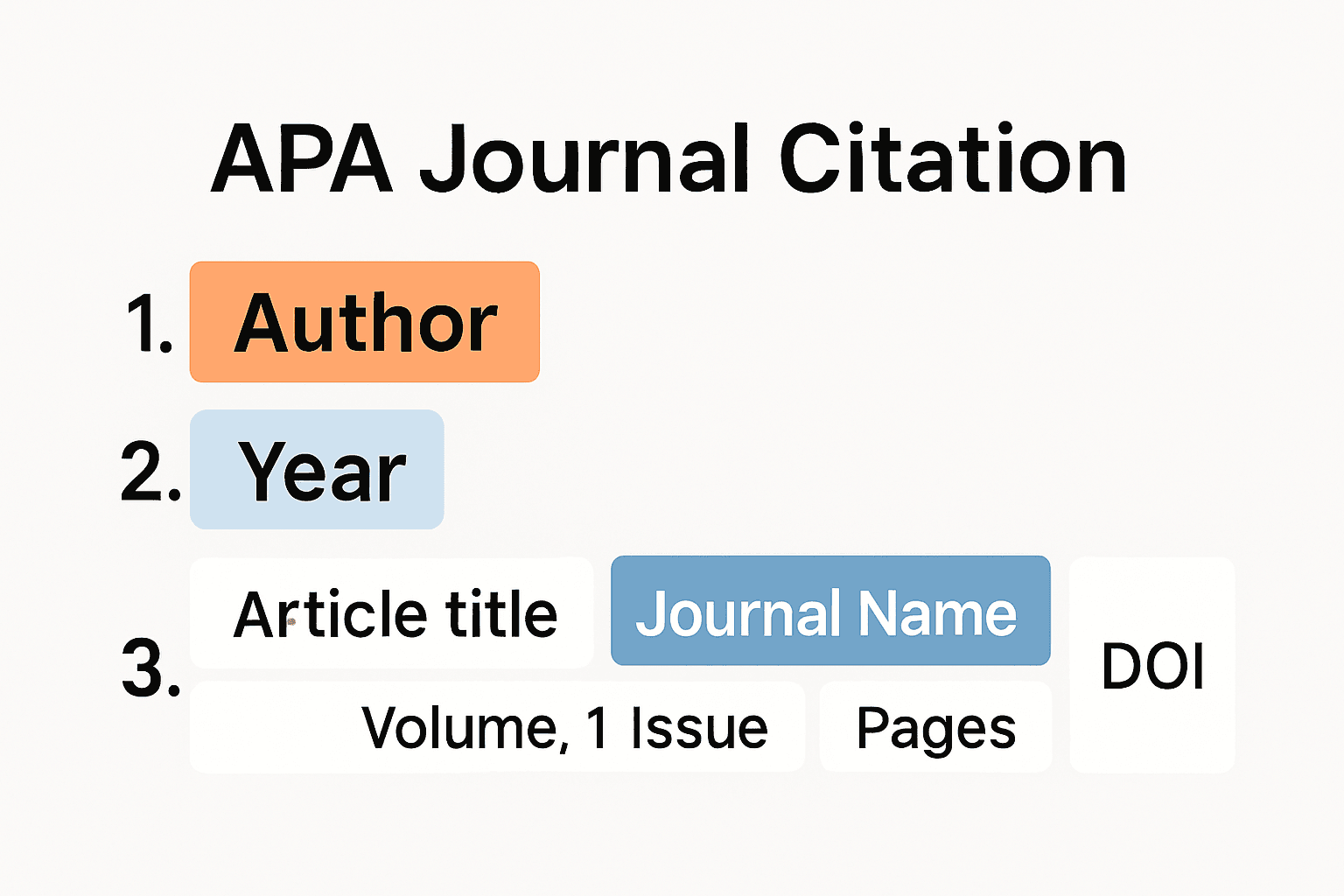Blog
Learning Materials
Wie man Zeitschriftenartikel im APA-Stil im Jahr 2025 zitiert
Updated: July 9, 2025

APA-Zitationen für akademische Zeitschriften können mühsam und überwältigend erscheinen, insbesondere mit den ständigen Aktualisierungen der offiziellen Richtlinien. Hier ist ein Twist. Über 70 Prozent der studentischen Autoren machen jedes Semester Fehler in APA-Referenzen, und viele merken es nie. Der eigentliche Schock ist, dass die meisten Fehler einfach und leicht zu beheben sind, wenn man ein paar Insider-Tricks kennt, was die korrekten Zitationen weniger stressig macht, als man denkt.
Inhaltsverzeichnis
- Grundlagen der APA-Zitation für akademische Zeitschriften
- Kernkomponenten von Zeitschriftenartikel-Zitationen
- Formatierung spezifischer Zitationselemente
- Schritt-für-Schritt-Anleitung zum Zitieren von Zeitschriftenartikeln
- Sammeln wesentlicher Zitationsinformationen
- Erstellen des Referenzeintrags
- Häufige APA-Zitationsfehler, die vermieden werden sollten
- Nützliche Werkzeuge für APA-Zeitschriftenzitationen
Kurze Zusammenfassung
| Erkenntnis | Erklärung |
|---|---|
| Kernkomponenten von APA-Zitationen | Eine vollständige APA-Zitation für Zeitschriftenartikel umfasst den Nachnamen des Autors, Initialen, Veröffentlichungsjahr, Artikeltitel, Zeitschriftenname, Bandnummer, Heftnummer und Seitenbereich oder DOI. |
| Sammeln von Zitationsinformationen | Vor dem Erstellen von Zitationen sollten wesentliche Elemente wie Autorennamen, Veröffentlichungsjahr und Artikel- oder Zeitschriftenspezifika zusammengestellt werden, um Fehler zu vermeiden. |
| Häufige Zitationsfehler | Vermeiden Sie häufige Fallstricke wie falsche Titelgroßschreibung und inkonsistente Formatierung zwischen In-Text-Zitationen und Referenzlisten, um die akademische Integrität zu wahren. |
| Nutzung von Zitationswerkzeugen | Nutzen Sie Referenzmanagement-Software, Online-Zitationsgeneratoren und Browser-Erweiterungen, um den Zitationsprozess zu vereinfachen und die Formatierungsgenauigkeit sicherzustellen. |
Grundlagen der APA-Zitation für akademische Zeitschriften
Zitationen von akademischen Zeitschriften im APA-Format erfordern Präzision und Aufmerksamkeit für spezifische Details, die eine ordnungsgemäße akademische Anerkennung und intellektuelle Transparenz gewährleisten. Das Verständnis dieser grundlegenden Prinzipien hilft Forschern, ihre Quellen genau und professionell zu kommunizieren.
Kernkomponenten von Zeitschriftenartikel-Zitationen
Die APA-Zitation für akademische Zeitschriften umfasst mehrere kritische Elemente, die eine standardisierte Referenz schaffen. Im Kern umfasst eine vollständige Zeitschriftenartikel-Zitation den Nachnamen des Autors, Initialen, Veröffentlichungsjahr, Artikeltitel, Zeitschriftenname, Bandnummer, Heftnummer und Seitenbereich oder Digital Object Identifier (DOI).

Die neueste APA 7. Ausgabe hat mehrere nuancierte Änderungen eingeführt, die Forscher verstehen müssen. Zum Beispiel erfahren Sie mehr über moderne Zitationstechniken, um sicherzustellen, dass Ihre Referenzen den aktuellen akademischen Standards entsprechen. Autoren müssen jetzt den DOI als Hyperlink einfügen, wenn verfügbar, was eine dauerhafte Möglichkeit bietet, die Originalquelle zu finden.
Formatierung spezifischer Zitationselemente
Beim Zitieren von Zeitschriftenartikeln gelten spezifische Formatierungsregeln. Laut Forschung der Monash University erfordern Artikel mit mehreren Autoren besondere Aufmerksamkeit. Bei Veröffentlichungen mit 21 oder mehr Autoren sollten Forscher die ersten 19 Namen auflisten, ein Auslassungszeichen einfügen und dann den letzten Autorennamen angeben. Dieser Ansatz gewährleistet eine umfassende Zuschreibung, während übermäßig lange Referenzen vermieden werden.
Digitale Veröffentlichungen haben einzigartige Überlegungen. Beim Verweisen auf einen Artikel mit einer Artikelnummer anstelle traditioneller Seitenzahlen müssen Forscher das Wort Artikel gefolgt von der spezifischen Artikelnummer einfügen. Bei Vorab-Online-Veröffentlichungen sollte die Zitation Advance online publication angeben und den DOI oder die URL enthalten.
Professionelle Forscher erkennen, dass genaue Zitationen mehr als technische Anforderungen sind. Sie repräsentieren intellektuelle Ehrlichkeit, ermöglichen es den Lesern, die Ursprünge von Ideen nachzuvollziehen, Forschungsansprüche zu validieren und sich mit dem breiteren akademischen Diskurs zu beschäftigen. Indem sie diese Zitationsgrundlagen beherrschen, demonstrieren Wissenschaftler Strenge und Respekt für den kollektiven Wissensaufbauprozess in ihren jeweiligen Bereichen.
Genaue APA-Zitationen dienen mehreren Zwecken: Sie verleihen der Forschung Glaubwürdigkeit, ermöglichen die Nachverfolgbarkeit von Wissen und geben den ursprünglichen Autoren die gebührende Anerkennung. Das Verständnis dieser grundlegenden Prinzipien stellt sicher, dass Ihr akademisches Schreiben den höchsten Standards der wissenschaftlichen Kommunikation entspricht.
Schritt-für-Schritt-Anleitung zum Zitieren von Zeitschriftenartikeln
Das Zitieren von akademischen Zeitschriftenartikeln erfordert einen systematischen Ansatz, der Genauigkeit und Einhaltung der APA-Richtlinien sicherstellt. Diese umfassende Anleitung führt Sie durch den genauen Prozess der Erstellung einer professionellen Zitation, die den wissenschaftlichen Standards entspricht.
Sammeln wesentlicher Zitationsinformationen
Bevor Sie mit Ihrer Zitation beginnen, sammeln Sie alle wichtigen Informationen aus dem Zeitschriftenartikel. Laut Simon Fraser Universitys citation guide müssen Sie die folgenden Schlüsselelemente zusammenstellen:
- Vollständiger Name des Autors/der Autoren
- Veröffentlichungsjahr
- Vollständiger Artikeltitel
- Vollständiger Zeitschriftenname
- Bandnummer
- Heftnummer (falls zutreffend)
- Seitenbereich oder Artikelnummer
- Digital Object Identifier (DOI) oder URL
Professionelle Forscher verstehen, dass sorgfältige Vorbereitung Zitationsfehler verhindert. Erforschen Sie fortgeschrittene Zitationstechniken, um Ihren akademischen Schreibprozess zu optimieren und Präzision sicherzustellen.
Erstellen des Referenzeintrags
Die APA 7. Ausgabe bietet spezifische Formatierungsrichtlinien für die Erstellung von Referenzeinträgen. Laut Victoria Universitys referencing guide folgt das Standardformat dieser Struktur:
Nachname des Autors, Initiale. (Jahr der Veröffentlichung). Artikeltitel. Zeitschriftenname, Bandnummer(Heftnummer), Seitenbereich. https://doi.org/xxxxx
Für digitale Veröffentlichungen ohne traditionelle Seitenzahlen fügen Sie die Artikelnummer vorangestellt mit dem Wort Artikel ein. Wenn eine Vorab-Online-Veröffentlichung keine vollständigen Veröffentlichungsinformationen enthält, verwenden Sie Advance online publication und fügen Sie den DOI oder die URL ein.
Wichtige Überlegungen für verschiedene Szenarien umfassen:
- Artikel mit einem einzigen Autor
- Veröffentlichungen mit mehreren Autoren
- Nur online verfügbare Zeitschriften
- Artikel mit Digital Object Identifiers
Forscher müssen auf Formatierungsdetails achten. Kursivieren Sie den Zeitschriftennamen und die Bandnummer, verwenden Sie Satzzeichen für den Artikeltitel und stellen Sie eine konsistente Interpunktion im gesamten Referenz sicher.
Der Zitationsprozess geht über bloße technische Einhaltung hinaus. Er stellt eine kritische Komponente der akademischen Integrität dar, indem er den Lesern einen klaren Weg bietet, die ursprüngliche Forschung zu überprüfen und zu erkunden. Indem Sie diese Zitationstechniken beherrschen, demonstrieren Sie wissenschaftliche Strenge und Respekt für intellektuelle Beiträge über akademische Disziplinen hinweg.
Um Ihnen zu helfen, die Unterschiede in der APA-Zitationsformatierung für verschiedene Arten von Zeitschriftenartikeln schnell zu erfassen, finden Sie hier eine Zusammenfassungstabelle, die die wichtigsten Unterschiede und erforderlichen Elemente in jedem Szenario hervorhebt:
| Szenario | Erforderliche Elemente | Bemerkenswerte Formatierungsregeln |
|---|---|---|
| Artikel mit einem einzigen Autor | Name des Autors, Jahr, Titel, Zeitschriftenname, Band, (Heft), Seiten oder DOI | Kursivieren Sie den Zeitschriftennamen & Band, Satzzeichen für den Titel |
| Mehrere Autoren ( | ||
| <21) | All authors' names, year, title, journal name, volume, (issue), pages or DOI | List all authors, use ampersand before last name |
| Multiple Authors (21+) | First 19 authors, ellipsis (...), last author, year, title, journal, volume, (issue) | Insert ellipsis after 19th author, list last author only |
| Article with Article Number | Author(s), year, title, journal name, volume, (issue), Article [number], DOI | Use "Article" before number instead of page range |
| Advance Online Publication | Author(s), year, title, journal name, (if available), Advance online publication, DOI | Note "Advance online publication"; include DOI or URL |
Common APA Citation Mistakes to Avoid
Academic writing demands precision, and APA citations are no exception. Researchers frequently encounter pitfalls that can compromise the credibility of their scholarly work. Understanding and avoiding these common errors is crucial for maintaining academic integrity and professional standards.
Formatting and Structural Errors
One of the most prevalent citation mistakes involves improper formatting and structural inconsistencies. According to Alvernia University's citation guide, researchers often make critical errors in title capitalization. Learn more about precise citation techniques to ensure your references meet the highest academic standards.
In APA 7th edition, only the first word of the title, the first word after a colon, and proper nouns should be capitalized. Many researchers mistakenly capitalize every word, which directly violates APA guidelines. For example, the title "The impact of climate change on marine ecosystems" should not have every word capitalized.
Another frequent mistake involves inconsistent formatting between in-text citations and the reference list. According to Purdue Global Writing Center, researchers must ensure that every in-text citation precisely matches its corresponding reference list entry, with identical author names and publication years.
To help you avoid the most common APA citation mistakes, the following table summarizes key errors and the best practices to correct them:
| Common Mistake | Explanation/Example | Best Practice |
|---|---|---|
| Over-capitalizing Article Titles | Capitalizing Every Word in the Title (e.g., "Climate Change Impacts") | Use sentence case; only the first word & proper nouns are capitalized |
| Inconsistent In-text vs. Reference List | Author names/dates differ between text and list | Double-check author names and years for consistency |
| Missing DOI or URL for Digital Sources | Omitting required DOI of an online article | Always include DOI as hyperlink if available |
| Mishandling Multiple Author Citations | Listing all authors for articles with 21+ authors | List first 19, then ellipsis, then final author |
| Not Noting Advance Online Publication | Forgetting to add "Advance online publication" for pre-publication articles | Add "Advance online publication" and the DOI/URL |
Digital Source Citation Challenges

Digital publications present unique citation challenges that often trip up even experienced researchers. The most critical error involves mishandling Digital Object Identifiers (DOIs). As recommended by academic citation experts, when a DOI is available, it must be included in the reference entry. For online sources without a DOI, researchers should provide the publisher's URL.
Multiple-author publications require careful attention. When a journal article has more than 20 authors, researchers must list the first 19 authors, use an ellipsis, and then list the final author's name. This approach maintains comprehensive attribution while preventing excessively long references.
Advance online publications demand special notation. Citations for these sources should include "Advance online publication" and the specific DOI or URL. Many researchers overlook these nuanced requirements, potentially compromising the accuracy of their citations.
Professional researchers recognize that citation errors are more than mere technical mistakes. They represent potential breaches of academic integrity. Each citation serves as a critical link in the scholarly conversation, allowing readers to trace the origins of ideas, validate research claims, and engage with the broader academic discourse.
By understanding and avoiding these common citation mistakes, researchers demonstrate their commitment to scholarly precision. Accurate citations are not just about following rules they are about respecting intellectual contributions and maintaining the highest standards of academic communication. Careful attention to detail ensures that your research stands up to the most rigorous academic scrutiny.
Useful Tools for APA Journal Citations
Navigating the complex world of academic citations requires sophisticated tools that streamline the research and referencing process. Modern researchers have access to powerful digital solutions that simplify APA journal citations, ensuring accuracy and saving valuable time.
Reference Management Software
Reference management software has revolutionized academic writing and citation processes. Explore advanced citation techniques to maximize your research efficiency. According to Wikipedia's technology overview, tools like Zotero offer comprehensive citation management capabilities.
Key reference management tools include:
- Zotero: A free, open-source reference management tool that integrates seamlessly with web browsers. It allows researchers to collect, organize, and cite research materials automatically.
- Mendeley: An advanced reference manager that combines citation management with academic networking features.
- JabRef: An open-source citation software supporting multiple research databases and citation formats.
To help compare the top reference management tools mentioned, the following table summarizes their core features and strengths:
| Tool | Cost | Notable Features | Integration |
|---|---|---|---|
| Zotero | Free | Open-source, browser integration, automatic citation | Web browsers, Word, Google Docs |
| Mendeley | Free* | Citation management, academic networking | Word, PDF annotation |
| JabRef | Free | Open-source, BibTeX/LaTeX support | Research databases |
*Note: Mendeley offers additional paid features.
Online Citation Generators
Online citation generators provide quick and reliable solutions for researchers struggling with complex APA formatting requirements. These web-based tools automatically generate correctly formatted citations by parsing article information. Researchers can simply input article details, and the generator produces perfectly structured references.
Top online citation generators offer features like:
- Instant APA 7th edition formatting
- Support for multiple publication types
- Direct integration with research databases
- Export options for various document formats
Browser and Word Processor Extensions
Modern citation tools extend beyond standalone software. Browser extensions and word processor plugins enable researchers to capture citation information directly from academic websites and insert references with minimal manual intervention.
These extensions typically provide:
- One-click citation capture
- Automatic bibliography generation
- Seamless integration with popular writing platforms
- Real-time formatting checks
Researchers must select tools that align with their specific workflow and institutional requirements. While these technologies significantly reduce citation-related stress, they are not infallible. Always double-check generated citations against official APA guidelines to ensure absolute accuracy.
The landscape of citation tools continues to evolve, with artificial intelligence and machine learning promising even more sophisticated solutions in the coming years. By leveraging these advanced technologies, researchers can focus more on their intellectual contributions and less on technical formatting challenges.
Frequently Asked Questions
What are the core components of an APA citation for academic journal articles?
A complete APA citation includes the author's last name, initials, publication year, article title, journal name, volume number, issue number, and page range or DOI.
How do I format multiple authors in an APA citation?
For articles with 21 or more authors, list the first 19 authors, insert an ellipsis, and then include the last author's name. For works with fewer than 21 authors, list all authors' names in the citation.
What should I do if my journal article doesn't have traditional page numbers?
If an article has an article number instead of page numbers, include the word "Article" followed by the article number in the citation. If it's an advance online publication, note it as "Advance online publication" and include the DOI or URL.
What common mistakes should I avoid when formatting APA citations?
Avoid over-capitalizing titles, ensuring consistent formatting between in-text citations and the reference list, and always including a DOI for digital sources when available.
Eliminate APA Stress: Let Samwell.ai Perfect Your Citations
Struggling with APA journal citations can make even the most confident writers feel overwhelmed. If you worry about small mistakes costing you points, missed DOIs, or confusing author formats, you are not alone. The article above highlights how tricky it is to keep up with evolving citation rules and how common errors in formatting and digital references can quickly derail your hard work.

Why keep risking errors when a smarter solution is available right now? Samwell.ai is designed to remove citation guesswork entirely. Our advanced platform helps you generate, review, and perfect APA references in seconds. Let our Semihuman.ai technology ensure every reference is accurate and original so you can focus on your research instead of citation formatting. Ready to take control and avoid common citation pitfalls discussed in this guide? Start building error-free references with Samwell.ai or discover more ways we support academic excellence in our APA citation research paper guide.
Recommended
Generate essays with Samwell.ai
Whether you’re a publisher, professor, journalist, or student, let us tailor a plan just for you.Meistgelesene Artikel

Ihr Leitfaden zum Erfolg beim Verfassen eines Aufsatzes
Expertentipps zum Verfassen eines Essays: von der Formulierung einer These bis zur effektiven Strukturierung Ihres Essays.

Tipps zum Schreiben: Strategien, um das Schreiben zu meistern
Verbessern Sie Ihr Essay-Schreiben mit Expertentipps zu Analyse, Thesenerstellung und beeindruckender Strukturierung.

Wie man einen kritischen Reflexionsaufsatz schreibt: Expertentipps
Expertentipps zum Verfassen eines kritischen Reflexionsaufsatzes. Lernen Sie, wie Sie strukturieren, Themen auswählen und Beweise effektiv nutzen.

Wie man einen guten Haken schreibt: Ein Schritt-für-Schritt-Leitfaden
Beherrschen Sie die Kunst, einen guten Haken zu kreieren, mit unserem Leitfaden. Erstellen Sie fesselnde Eröffnungen für einen unvergesslichen ersten Eindruck.
